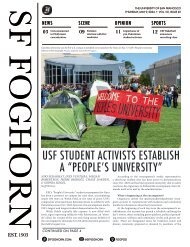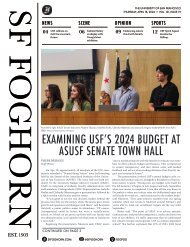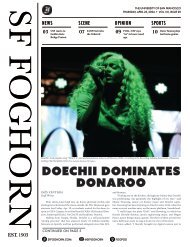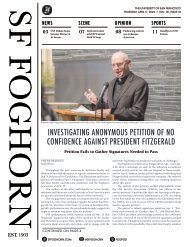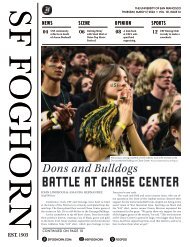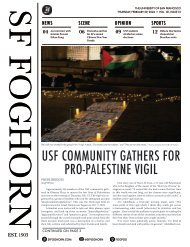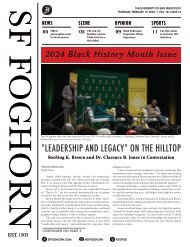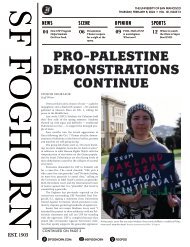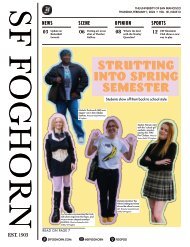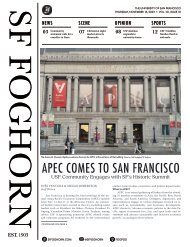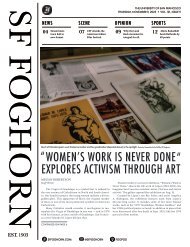Create successful ePaper yourself
Turn your PDF publications into a flip-book with our unique Google optimized e-Paper software.
SF FOGHORN<br />
EST. 1903<br />
NEWS<br />
03<br />
Students educate<br />
at “Untold Stories”<br />
teach-in.<br />
READ ON PAGE 4<br />
SFFOGHORN.COM<br />
SCENE<br />
08<br />
USF’s “Sanctuary<br />
City” project heads<br />
to Rome.<br />
A Look into the<br />
@SFFOGHORN<br />
OPINION<br />
11<br />
FOGPOD<br />
THE UNIVERSITY OF SAN FRANCISCO<br />
THURSDAY, MAY 2, 2024 • VOL. 121, ISSUE 21<br />
Reflecting on<br />
AAPI history in<br />
SF.<br />
St. Ignatius<br />
Church<br />
and its<br />
Renovations<br />
SPORTS<br />
12<br />
Spring sports<br />
compete in WCC<br />
Championships.<br />
St. Ignatius came to the Hilltop in 1914, after the 1906 “Ham and Eggs” Hayes Valley<br />
Fire destroyed the previous location of the church. Photo by Samantha Avila Griffin/SF Foghorn.
02 03<br />
THURSDAY<br />
MAY 2<br />
2024<br />
STAFF<br />
Editor in Chief<br />
MEGAN ROBERTSON<br />
mrrobertson2@dons.usfca.edu<br />
News Editor<br />
NIKI SEDAGHAT<br />
nisedaghat@dons.usfca.edu<br />
Opinion Editor<br />
CHISOM OKORAFOR<br />
cokorafor@dons.usfca.edu<br />
Scene Editor<br />
INÉS VENTURA<br />
ipventura@dons.usfca.edu<br />
Sports Editor<br />
CHASE DARDEN<br />
cbdarden@dons.usfca.edu<br />
Photography Editor<br />
SAMANTHA AVILA GRIFFIN<br />
svavilagriffin@dons.usfca.edu<br />
General Reporter<br />
PHEBE BRIDGES<br />
pjbridges@dons.usfca.edu<br />
General Reporter<br />
ELINA GRAHAM<br />
emgraham@dons.usfca.edu<br />
415.422.5444<br />
sffoghorn.com<br />
SUBMISSION POLICY<br />
The San Francisco Foghorn is the<br />
official student newspaper of the<br />
University of San Francisco and<br />
is sponsored by the Associated<br />
Students of the University of San<br />
Francisco (ASUSF).<br />
The thoughts and opinions<br />
expressed herein are those of the<br />
individual writers and do not<br />
necessarily reflect those of the<br />
Foghorn staff, the administration,<br />
the faculty, staff or the students of<br />
the University of San Francisco.<br />
Contents of each issue are the sole<br />
responsibilities of the editors.<br />
An All-American<br />
Publication<br />
ad maiorem dei<br />
gloriam<br />
The San Francisco Foghorn is free<br />
of charge.<br />
Advertising matter printed herein<br />
is solely for informational purposes.<br />
Such printing is not to be construed<br />
as written or implied sponsorship<br />
or endorsement of such commercial<br />
enterprises or ventures by the San<br />
Francisco Foghorn.<br />
©MMIV-MMV, San Francisco<br />
Foghorn. All rights reserved. No<br />
material printed herein may be reproduced<br />
without prior permission<br />
of the Editor in Chief.<br />
SAN FRANCISCO<br />
FOGHORN<br />
Freedom and Fairness<br />
Managing Editor<br />
JORDAN PREMMER<br />
jepremmer@dons.usfca.edu<br />
Copy Editor<br />
SOPHIA SIEGEL<br />
scsiegel@dons.usfca.edu<br />
Layout Editor<br />
ANYA JORDAN<br />
arjordan@dons.usfca.edu<br />
Layout Editor<br />
HALLEY COMPUTESTO<br />
hmcompuesto@dons.usfca.edu<br />
Social Media Manager<br />
MARIA ZAIED<br />
mfzaied@dons.usfca.edu<br />
Online Editor<br />
ESHA DUPUGUNTLA<br />
ekdupuguntla@dons.usfca.edu<br />
ADVISOR<br />
TERESA MOORE<br />
2130 FULTON STREET, UC #417<br />
SAN FRANCISCO, CA 94117<br />
Columns for the Opinion section<br />
and Letters to the Editor are gladly<br />
accepted from students, faculty, staff<br />
and alumni.<br />
All materials must be signed and<br />
include your printed name, university<br />
status (class standing or title),<br />
address, and telephone number for<br />
verification. Anonymous submissions<br />
are not published.<br />
We reserve the right to edit materials<br />
submitted. All submissions<br />
become the property of the San<br />
Francisco Foghorn.<br />
Staff editorials are written by the<br />
Foghorn editorial staff and represent<br />
a group consensus.<br />
The San Francisco Foghorn Opinion<br />
page is a forum for the free, fair and<br />
civil exchange of ideas. Contributors’<br />
opinions are not meant to<br />
reflect the views of the Foghorn staff<br />
or the University of San Francisco.<br />
Students interested in contributing<br />
to the Foghorn can scan and fill out<br />
the QR code below.<br />
STAFF EDITORIAL<br />
AAPI heritage Month<br />
THE SIGNIFICANCE OF AAPI<br />
COMMUNITIES TO THE 2024 ELECTION<br />
Asian Americans are the fastest-growing<br />
voter demographic in the<br />
United States, Pew Research Center<br />
reported in January. Despite their<br />
rapidly growing importance, our politicians<br />
don’t take concerns from the<br />
Asian American voting bloc as seriously<br />
as needed.<br />
This election season, Asian<br />
Americans need to be recognized by<br />
our political institutions as the vitally<br />
important political demographic<br />
they are. Tangible steps need to be<br />
taken toward increasing accessibility<br />
in our political systems.<br />
A February article from the New<br />
York Times revealed that as recently<br />
as 2020, the Asian American voter<br />
demographic is typically disregarded<br />
during election seasons in critical<br />
election states like Georgia, under<br />
the assumption that they wouldn’t<br />
turn out to vote. This assumption is<br />
patently false, as the Asian and Pacific<br />
Islander American Vote Organization<br />
found that the Asian American<br />
and Pacific Islander (AAPI) American<br />
communities have been turning<br />
out in record numbers for several<br />
election cycles now. According to<br />
AAPI Data, in Georgia, the AAPI voter<br />
turnout jumped a staggering 84%<br />
in 2020.<br />
The assumption that Asian<br />
Americans don’t vote causes politicians<br />
to not reach out to these communities.<br />
During the 2022 midterms,<br />
an Asian and Pacific Islander American<br />
Vote Organization poll found<br />
Photo courtesy of @apiavote on Instagram.<br />
that “More than two-thirds of registered<br />
Asian Americans surveyed say<br />
they plan to vote, but only about half<br />
have been contacted by either of the<br />
major parties.”<br />
Aside from underestimating the<br />
AAPI vote, part of the problem is that<br />
the AAPI voter demographic requires<br />
unique political outreach strategies.<br />
Pew Research Center found that<br />
“Asian Americans are the only major<br />
racial or ethnic group where more of<br />
its eligible voters are naturalized citizens<br />
than U.S.-born citizens (56% vs.<br />
44%).” This often means that to effectively<br />
contact the community, politicians<br />
need to use languages other<br />
than English. According to the Asian<br />
American Federation, language barriers<br />
often prevent AAPI voters from<br />
fully participating. While language<br />
accessibility is increasing over time,<br />
many politicians haven’t expanded to<br />
languages commonly spoken by the<br />
incredibly diverse AAPI diaspora,<br />
such as Mandarin, Japanese or Tagalog.<br />
If politicians want to mobilize<br />
this rapidly growing demographic,<br />
they need to be more serious about<br />
language accessibility to start.<br />
Democracy takes a lot of work.<br />
We’ve all seen how easily it can be<br />
threatened, especially during this<br />
election season. But we can’t fully<br />
claim the democratic ideals this<br />
country was founded upon if we’re<br />
not serious about letting everyone in,<br />
including and especially those, who<br />
have been historically overlooked.<br />
“THE UNTOLD STORIES” OF SUDAN, THE CONGO, AND<br />
PALESTINE ON DISPLAY AT USF STUDENT TEACH-IN<br />
CHISOM OKORAFOR<br />
Staff Writer<br />
On Apr. 26, approximately 80 students<br />
crowded into the Berman Room of Fromm Hall<br />
for a teach-in about international oppression.<br />
At “The Untold Stories,” an event hosted by the<br />
Public Health Society in collaboration with the<br />
Middle East & North Africa Club, students from<br />
the Democratic Republic of the Congo, Sudan<br />
and the occupied Palestinian territories educated<br />
students about the struggles of their home<br />
countries.<br />
Speakers provided context for the current<br />
violence their nations face. Audience member<br />
Jaiden Woods, a sophomore international studies<br />
major said, “Honestly, I was so impressed<br />
with all the [speakers], you can see how difficult<br />
this is for them…the strength and resilience…<br />
to do this for their country, and their people…<br />
[and] make sure this gets out to our community on campus — it’s really<br />
amazing.”<br />
The Democratic Republic of the Congo<br />
Sylvia Rubuye is the president of USF’s Public Health Society, a student<br />
organization which educates and collaborates with communities<br />
in public health. Rubuye spoke about the Congo.<br />
In her speech, Rubuye explained that a history of violent colonialism<br />
and resource exploitation had created the conditions for the Congo’s<br />
“silent genocide.” According to Migrants’ Rights Network, “today,<br />
Congolese civilians are being massacred by the Rwanda-backed M23<br />
rebels, as part of a long history of Western and corporate intervention.”<br />
Rubuye said, “I remember talking with my dad…[and] him telling<br />
me how he almost lost his life… Unfortunately… my uncle was not<br />
as lucky. I remember my dad telling me about the grief he had to go<br />
through after losing his brother from being decapitated.”<br />
In East Congo, violent militant groups from neighboring countries<br />
like Rwanda and Burundi have been slaughtering and mass-raping the<br />
Congolese people, according to the United Nations. The crisis is driven<br />
by the desire for lucrative natural resources. The Congo is one of the<br />
most natural-resource-rich countries in the world, but its people largely<br />
live in poverty and exploitation. Minerals like cobalt, an essential<br />
resource for the technology industry, are mined by workers, including<br />
children, who face slavery-like conditions.<br />
Rubuye said, “This is not just a war about Africans wanting the<br />
resources of the Congo… the entire world benefits from it…I’m asking<br />
people from the bottom of my heart to never stop caring about Congo.”<br />
Sudan<br />
Rawan Abdalla, senior media studies major, presented on Sudan.<br />
“I’ve spoken to many people… and I’ve been told, ‘Oh, I didn’t know<br />
there was a war going on in your country,’” she said.<br />
On Apr. 15, the humanitarian crisis in Sudan passed the one-year<br />
mark. More than 15,000 civilians have been killed, largely centered in<br />
the capital city Khartoum, but also wracking the rest of the country,<br />
particularly Darfur, the site of the Darfur genocide, which ended in<br />
2020. Man y of the Janjaweed militants who committed that genocide<br />
have become the Rapid Support Forces (RSF) that are now engaged in<br />
fighting against the Sudanese Armed Forces. According to the United<br />
States Agency for International Development, eight million Sudanese<br />
people have been forced to flee their homes, making it “the largest displacement<br />
crisis in the world.”<br />
Sylvia Rubuye, pictured above, told the Foghorn, “I was so happy with the turnout because we had twice as<br />
many people as we expected.” Photo by Samantha Avila Griffin/SF Foghorn.<br />
Abdalla pointed to a picture of herself with family members. “This<br />
cousin, they fled to Egypt, and as for my niece and nephew, we actually<br />
don’t know where they are. So we have a lot of family on both sides that<br />
have been missing… I had some family that refused to leave, which resulted<br />
in deaths.”<br />
Palestine<br />
One Palestinian organizer who spoke about the ongoing genocide<br />
in Gaza told the Foghorn, “Our main goal, obviously, is to educate… If<br />
one person walks away from this educated, that’s good enough for us.”<br />
The Foghorn has granted this speaker anonymity, per their request, citing<br />
safety threats and fear of retaliation towards Palestinian students<br />
nationally.<br />
Two student speakers for Palestine laid out the violence of Israel’s<br />
aggression on Gaza, using videos and infographics to illustrate the scale<br />
of the death and destruction. The death toll in Gaza has crossed 34,000,<br />
according to Al-Jazeera. However, authorities have lost an accurate<br />
count of the dead in Gaza given the collapse of civil services, according<br />
to the Wall Street Journal. Even before Oct. 7, 2023, Palestinians faced<br />
a lack of adequate resources for survival, but the situation has escalated.<br />
According to the U.S. Secretary of State Anthony Blinken, 100% of the<br />
Gazan population is now food insecure. In the West Bank, Palestinians<br />
face an oppressive apartheid system and violence from Israeli settlers,<br />
whose illegal settlements increasingly encroach on Palestinian land.<br />
Audience member Roman Szydlik, a junior marketing and management<br />
major, said of the event, “It was definitely very eye-opening. …The<br />
students speaking [about what] their families are experiencing… I mean<br />
the whole time I was crying.”<br />
She continued, “I feel like I haven’t participated as much as I wanted<br />
to on campus… a lot of the reason why we don’t speak out or something<br />
is… I didn’t know a lot about it, so now I feel like I have the confidence<br />
with… the information that they provided.”<br />
On Apr. 29, a walkout calling for USF to divest from Israeli-occupation<br />
affiliated endowments and investments, among other demands,<br />
turned into the creation of a “people’s university” encampment on Welch<br />
Field. The Foghorn will publish our reporting on this Gaza solidarity<br />
encampment in our May 9 issue.<br />
Editor-in-Chief: Megan Robertson, Chief Copy Editor: Sophia Siegel,<br />
Managing Editor: Jordan Premmer, News Editor: Niki Sedaghat<br />
NEWS
04 05<br />
THURSDAY<br />
MAY 2<br />
2024<br />
CONTINUED FROM FRONT PAGE<br />
ST. IGNATIUS PARISH FOSTERS<br />
COMMUNITY FROM THE HILLTOP<br />
The church is the official location for San Francisco Fire<br />
and Police Department funeral services. Photo by Veston<br />
Smith/SF Foghorn.<br />
NEWS<br />
PAOLA SAAVEDRA & VESTON SMITH<br />
Contributing Writers<br />
Parishioners filled the pews of St. Ignatius Church at 10 a.m. on a<br />
Sunday last fall. Visitors placed pies on a table by the entrance marked<br />
“Thanksgiving pie drive,” under the church’s vaulted ceiling, which<br />
is adorned with a painting of St. Ignatius. The Rev. Father Greg Bonfiglio,<br />
S.J. strolled the pews welcoming parishioners as they entered.<br />
While their Catholic faith brings people to mass, what keeps them<br />
coming back to St. Ignatius are the connections between parishioners,<br />
staff, religious professionals and the community they serve. St. Ignatius<br />
sustains the community through outreach initiatives and a welcoming<br />
and nuanced service.<br />
“What drew us was the quality of the homilies, and the thoughts<br />
and the ideas of the parish,” said church volunteer Terry Potente, who<br />
joined the St. Ignatius parish 12 years ago. “The community is very<br />
welcoming and friendly.”<br />
While some students’ primary interactions with the church are<br />
limited to the beginning and end of their time on campus, students are<br />
welcome to, and do, attend the church services.<br />
Sarah McKinley is a USF graduate student whose family joined<br />
the St. Ignatius Parish when she was in middle school, after her family<br />
relocated to the Bay Area from Minnesota. “Moving to San Francisco<br />
was a huge change for me and my family,” she said. “Everything was so<br />
Bonfiglio told the Foghorn regarding the scaffolding, “If it’s not all going to be down, [the] majority of it will be,” by May commencement.<br />
Photo by Veston Smith/SF Foghorn.<br />
new and different, and sometimes, honestly, it felt a little overwhelming.<br />
But having a church home like St. Ignatius was a calming presence<br />
in the midst of all that change.”<br />
McKinley said that St. Ignatius Parish played a part in her decision<br />
to attend graduate school at USF. “The church had a huge influence,”<br />
she said. “The sense of community and shared values I found<br />
here made USF an attractive choice. It felt like a continuation of the<br />
support and spirit I experienced every week at mass.”<br />
“When I first got to USF, I figured church and school would be<br />
separate things in my life, but they’ve actually overlapped a lot,” she<br />
said. McKinley appreciates being able to drop in at St. Ignatius Church.<br />
“It’s kind of like my go-to spot when everything on campus gets too<br />
much. If I’m ever stressed or just need a quiet moment, I can always<br />
pop over to the church, eat lunch, sit down for a bit, and just chill out.”<br />
She said she sees cohesion between her studies and her faith. “I’ve<br />
found that what I learn and do at church often links up with my classes.<br />
Like, the whole thing about caring for others, fighting for what’s<br />
right, and being ethical – these are things I hear about in church, and<br />
then I find myself discussing them in my classes, especially in subjects<br />
like ethics or even some of my business courses. It’s pretty cool<br />
when stuff from a sermon at church comes up in class discussions. It<br />
makes everything I’m learning feel more connected, like my faith and<br />
my studies are part of the same journey.”<br />
The parish operates independently from the university, but they<br />
have a working relationship. St.<br />
Ignatius Parish shares its building<br />
with the USF, and the church<br />
serves as the chapel for the<br />
University. Angélica Quiñónez,<br />
director of University Ministry,<br />
said, “We view St. Ignatius<br />
Church as one of our most valuable<br />
partners.”<br />
Being so valuable to USF’s<br />
campus, construction on the<br />
church has been noticeable<br />
since it began in early May 2023,<br />
as previously reported by the<br />
Foghorn. According to Bonfiglio,<br />
“Most everything is going<br />
to wrap up by the end of June<br />
[2024].” The only thing expected<br />
to extend beyond June is the<br />
implementation of a fire suppression<br />
system, “but visually<br />
everything that we’ve set out to<br />
do will be done by June,” Bonfiglio<br />
confirmed.<br />
As of the update posted on<br />
Apr. 15 to the USF’s facilities<br />
website, it’s projected that the<br />
scaffolding removal will continue<br />
through May 9. “If it’s not all<br />
going to be down, [the] majority<br />
of it will be, and those who<br />
are graduating will be able to take pictures without<br />
scaffolding in the background,” Bonfiglio said.<br />
Beyond USF, the church has historically been a pillar of<br />
San Francisco. “The building was used in the day as a navigation<br />
point for ships coming to the Golden Gate,” said Bonfiglio.<br />
“It was the highest building in the city so you could<br />
see it from outside the Golden Gate even before the bridge.”<br />
Nicknamed the “Beacon on the Hill,” it has continued to<br />
serve as a focal point of San Francisco’s skyline. Before existing<br />
in three other sites since the Jesuits first established it<br />
in 1855, St. Ignatius Church settled at its “forever home” on<br />
the Hilltop in 1914.<br />
In 2020, the COVID-19 pandemic brought new challenges<br />
to the church. The church’s home of San Francisco<br />
was one of the first to issue a citywide lockdown —from<br />
Mar. 17, 2020, to Jan. 25, 2021, Mayor London Breed ordered<br />
a lockdown on congregate gatherings. However, San Francisco<br />
Archbishop Salvatore Cordileone was very vocal about<br />
his opposition to mandated church closures and resisted<br />
city public health ordinances.<br />
Before the city’s shelter-in-place order went into effect,<br />
Bonfiglio canceled mass in hopes of protecting his congregation<br />
from the virus. However, when he wrote a letter to<br />
Cordileone, requesting permission to cancel mass on Sunday,<br />
Mar. 15, 2020, the archbishop denied his request.<br />
“I don’t think that keeps us safe,” said Bonfiglio. “So I<br />
sent an email to parishioners, and I’m clear we are having<br />
mass at 10:00 a.m. on Sunday, but please do not come, and<br />
so people didn’t.” Instead, parishioners were invited to join<br />
in on Zoom for mass.<br />
The church, which hosts USF’s May and December<br />
graduations as well as several music events, was already<br />
equipped with cameras and microphones. Patrick Steacy,<br />
media producer for USF, produced a live-stream of that Sunday’s<br />
service.<br />
St. Ignatius has a sister parish, San Antonio Parish, in Soyapango, El Salvador. Photo by Veston<br />
Smith/SF Foghorn.<br />
NEWS
06 07<br />
THURSDAY<br />
MAY 2<br />
2024<br />
CONTINUED FROM PAGE 5<br />
ST. IGNATIUS — A PILLAR OF SAN<br />
FRANCISCO<br />
According to a profile from Pitchfork, Kamaiyah’s biggest<br />
music inspirations are Missy Elliott, TLC, and MC Lyte.<br />
Photo courtesy of Marquise.<br />
Easter of 2020 fell about a month into the lockdown. “On Holy<br />
Thursday [2020] we were about to start mass and Father Greg was<br />
in tears because this church was so depressing,” said Don Crean, St.<br />
Ignatius’ Director of Sacramental Preparation. “We were walking up<br />
the aisles and there were all these empty pews.”<br />
Bonfiglio asked parishioners to send in photos of themselves to<br />
be taped to the empty pews. At the peak of the COVID-19 lockdown,<br />
the livestream attracted approximately 2,000 participants, more than<br />
double what the church could hold in person. There is still a livestream<br />
service for those who cannot physically make it to mass.<br />
Crean said kinship is vital to the parish. “We are fed by the sense<br />
of community that we share with one another, as we come to know<br />
one another, as the body of Christ, and ourselves,” he said.<br />
Parishioners extend community by leading food, clothing and<br />
toiletry drives for donations for shelters in San Francisco.<br />
The congregation also hosts “Home for Dinner” a few times a<br />
year. Bonfiglio invites the congregation to enjoy a community meal<br />
following the 10 a.m. mass, inspired by his grandmother. “I issued<br />
[her] warm obligation,” he said. “This is what my grandmother<br />
felt when she would have her family around her<br />
dinner table every Sunday.”<br />
The tradition recommenced when the pandemic restrictions<br />
were lifted. The next “Home for Dinner” will be<br />
on May 19 at 10 a.m.<br />
Bonfiglio said of the parishioners’ mission, “We’re<br />
reminding them of God’s love, for them, for all of us, and<br />
we’re reminded that God calls us, and God calls us in a<br />
particular way, to love, to love ourselves, to love the world<br />
around us.”<br />
Keeping Up With Kamaiyah<br />
Oakland Rapper Returns to Bay Area<br />
NEWS<br />
When asked for a rough estimate on the timeline, Bonfiglio<br />
said the church was approximately “85-90%” done with the<br />
renovation process. Photo by Samantha Avila Griffin/SF Foghorn.<br />
St. Ignatius Parish holds a USF Student Mass on Sundays at<br />
7 p.m. Photo by Samantha Avila Griffin/SF Foghorn.<br />
For more information regarding St. Ignatius’ mass<br />
schedule, check their website.<br />
Phebe Bridges and Niki Sedaghat contributed to the<br />
reporting of this story.<br />
Editor-in-Chief: Megan Robertson, Chief Copy Editor:<br />
Sophia Siegel, Managing Editor: Jordan Premmer, News<br />
Editor: Niki Sedaghat<br />
ELINA GRAHAM<br />
Staff Writer<br />
The stage of the Great American Music Hall was transformed into<br />
a propped liquor storefront of the “Oak Town Market” — complete<br />
with a neon flashing “open” sign — for Kamaiyah’s hometown show of<br />
her “Another Summer Night” tour on Apr. 18.<br />
The rapper presided over the crowd from the stage’s balcony as<br />
she performed her latest release “Can’t Lose.” Born and raised in East<br />
Oakland, Kamaiyah was recording her rhymes in the studio at age 11.<br />
Now platinum certified, she has more than established herself as one<br />
of the big names of the West Coast rap game. Kamaiyah’s debut album,<br />
“A Good Night in the Ghetto” made Rolling Stone’s and Pitchfork’s<br />
“Best Rap Album of 2016” lists. On top of that, she has collaborated<br />
with popular rappers, YG and Drake. She even founded two record<br />
labels, GRND.WRK, in 2020, and Keep it Lit Records under Empire,<br />
making her “one of few women in hip-hop, and perhaps the first from<br />
the West Coast, to run her own shop,” according to VIBE.<br />
Outfitted in a monochromatic white Supreme tracksuit with a<br />
manicure to match, Kamaiyah quickly established a rapport with the<br />
crowd, as beach balls and inflatable toys were tossed around on the<br />
floor below her.<br />
“Live music gives you a personal interaction and experience with<br />
an artist,” Kamaiyah said to the Foghorn, “It brings you into the world<br />
they build on that stage inside that venue.” She continued, “My music<br />
in that landscaping is an escape for people, the club or house party<br />
you’ve been dying to get to on your off-day.”<br />
Six artists took the floor before Kamaiyah — among them were<br />
female rappers Getitindy, Ally Cocaine and Cuhdeejah. The Vallejo-based<br />
Getitindy performed “Gas Me Up,” her latest release in<br />
collaboration with Kamaiyah. After the performance, she called a<br />
mega-fan onstage and presented her with flowers in thanks for her<br />
support. Following GetItIndy, Ally Cocaine, in a pink Y2K newsboy<br />
hat and sparkling knee-high boots, performed “Speak Up,” a song that<br />
invites critics to “say it with your chest.”<br />
In between artist performances, plenty of DJs kept the room’s energy<br />
up. Paying homage to Oakland’s hyphy legacy, Bay Area rap classics<br />
like Too $hort’s “Blow the Whistle” and Mac Dre’s “Feelin’ Myself”<br />
blasted from the speakers. “Hyphy”, which means hyperactive,<br />
refers to a subgenre of hip-hop that found its roots in the Bay Area in<br />
the early 2000s.<br />
Openers continued the communal house-party feel for more than<br />
two hours, and brought up audience members onstage to dance, blurring<br />
the barrier between audience and performers.<br />
“[The] openers all put on great shows, and I got excited once they<br />
started to set up for [Kamaiyah] to come out,” said attendee Maggie<br />
Mordecai, a junior politics major at USF. “They brought out props that<br />
resembled markets in Oakland and touched back to her roots where<br />
she began, which was cool to see…she made it special since she was<br />
back in the Bay.”<br />
In an interview with Vice, Kamaiyah describes how although<br />
her sound contains the “essence of the Bay Area,” she doesn’t want to<br />
make hometown fame her goal. Rather, she wants to continue evolving<br />
her music and finding her niche, going above and beyond what’s<br />
trending, rather than settling into a stagnant style to fit in with the<br />
genre of today.<br />
Her latest album, “Another Summer Night” has been described by<br />
KQED as “full of player attitude and trunk-rattling bass.”Close listeners<br />
won’t miss lyrics that speak to dealing with greedy backstabbers,<br />
navigating the loss of loved ones and the struggles of establishing success<br />
within the entertainment industry, in songs like “Whole Lotta<br />
M’s,” “Going Thru S—t” and “Lamborghini Dreams.”<br />
“I hope the audience takes away love and empowerment when I<br />
get off the stage because all I’m doing is pushing happiness, fun, and<br />
peace,” Kamaiyah said. “We don’t condone violence and we always<br />
have fun and safe environments. My fans are my family, so I always<br />
want them to feel they’re loved as such.”<br />
Other Goldenvoice-presented events can be found on the Goldenvoice<br />
website.<br />
Editor-in-Chief: Megan Robertson, Chief Copy Editor: Sophia Siegel,<br />
Managing Editor: Jordan Premmer, Scene Editor: Inés Ventura<br />
SCENE
08 09<br />
THURSDAY<br />
MAY 2<br />
2024<br />
SCENE<br />
SANCTUARY<br />
CITY GOES<br />
GLOBAL<br />
USF housed art exhibit<br />
to show in Italy this<br />
summer<br />
INÉS VENTURA<br />
Staff Writer<br />
Bold in their sentiment and block-lettered print, statements<br />
such as “Undocumented unafraid,” “I am an immigrant” and “This is<br />
a sanctuary,” can be seen on posters, tote bags, billboards, and just<br />
about any flat surface that text can be screen printed onto, as part of<br />
the “Sanctuary City” project.<br />
Sergio De La Torre, associate professor of fine arts in the<br />
Department of Arts + Architecture, is the beating heart of this art<br />
project that involves community and conversation around migration,<br />
surveillance and security. Based in research and data analysis, the<br />
project “engages individuals and institutions into deep dialogues<br />
regarding sanctuary cities & immigration policies,” according to their<br />
website.<br />
The collection started as a research project in 2007 supported<br />
by the Creative Work Fund, focused on the migration patterns and<br />
implications at the U.S. border with Mexico. The work was later the<br />
basis for the “Art as Citizen” class offered in the art department at<br />
USF.<br />
This summer, the Sanctuary City project will be shown at the<br />
Museo dell’Altro e dell’Altrove di Metropoliz (Museum of the Other<br />
and the Elsewhere), or MAAM, in Rome, Italy.<br />
A sanctuary city, as defined by the Center for Immigration<br />
Studies, can be a city, country, or state that has rules and regulations<br />
“that obstruct immigration enforcement and shield criminals from<br />
[U.S. Immigration and Customs Enforcement] ICE…[by] denying<br />
ICE access to interview incarcerated [undocumented immigrants],<br />
or otherwise impeding communication or information exchanges<br />
The art project has been displayed at several museums and galleries across the country,<br />
including at the SFMOMA in 2017. Photo Courtesy of Sergio De La Torre.<br />
The “Sanctuary City’s” billboard (pictured above) is on display over Mission street. Photo Courtesy of Sergio De La Torre.<br />
between their personnel and federal immigration officers.” California<br />
became a sanctuary state under former Governor Jerry Brown on Oct.<br />
5, 2017.<br />
De La Torre said, “You look for empathy with this project, you look<br />
to be compassionate. To be like… what if you were in a situation where<br />
you had to leave your country? Nobody wants to leave their country.<br />
Nobody wants to move from Guatemala to Canada. But they have to<br />
because they have no choice.”<br />
De La Torre was born in National City, Calif., but grew up in<br />
Tijuana, Mexico. Crossing the border his entire life, De La Torre<br />
has witnessed the ever-changing nature of border security. He was<br />
introduced to his partner in the project, Chris Treggiari in 2007<br />
— when Treggiari was a graduate student at the San Francisco Art<br />
Institute and De La Torre was conducting his research.<br />
Treggiari said, “One of my big tenets in my work is mobility,<br />
and allowing the arts to reach the public space; to reach out into<br />
communities and to engage in communities and dialogue.” Treggiari<br />
has been a professor at the California College of the Arts since 2013.<br />
Treggiari peddles a mobile print-making stand, where the Sanctuary<br />
City posters first started coming out in 2017.<br />
MAAM is a sanctuary in itself. Originally a slaughterhouse, the<br />
converted art museum currently “houses around 200 people, including<br />
60 families with children, hailing from all around the world,” according<br />
to Culture Trip. Treggiari said, “They are a museum for the people — a<br />
museum for the immigrants.” The content of Sanctuary City is based<br />
on the conversations that take place where the art is, with posters<br />
being unique to each location.<br />
The topic of migration is not easy to tackle for some. De<br />
La Torre said, “So you get into these conversations that are<br />
exhausting at some points, but then again, you somehow have<br />
to be patient and just …listen to them, and work with what they<br />
have, in order to understand.”<br />
In terms of challenges that the project faces, Treggiari<br />
said, “you never know what you’re going to get… immigration<br />
is hotly contested right now… I think we are going to run into<br />
some heated conversations… we look to have constructive<br />
conversations.”<br />
De La Torre said, “We’re making up laws in order to stop<br />
migration… no one can stop it because we have been doing this<br />
for centuries. We’ve been walking for centuries, now we take<br />
trains, and cars, and boats, airplanes; but before we used to<br />
walk — before borders were constructed.”<br />
Editor-in-Chief: Megan Robertson, Chief Copy Editor:<br />
Sophia Siegel, Managing Editor: Jordan Premmer, Scene Editor:<br />
Inés Ventura<br />
AI’S MECHANIZATION OF WORKERS<br />
EMILY LUTRICK is a sophomore<br />
chemistry major.<br />
Amazon’s Just Walk Out Uses Not-So-Artificial Intelligence<br />
In early April, reports surfaced<br />
revealing that Amazon’s Just Walk<br />
Out Artificial Intelligence (AI)<br />
technology wasn’t really what we<br />
thought it was.<br />
Amazon’s Just Walk Out<br />
technology was first implemented in<br />
Amazon Go convenience stores and<br />
Amazon Fresh grocery stores across<br />
the nation. To shop at these stores,<br />
customers must tap their credit or<br />
debit card, Amazon app, or their<br />
palm (if registered with Amazon)<br />
which lets them pass the entry gate.<br />
Then, the customer shops as usual<br />
while “sensors, cameras, and deep<br />
learning tools” sense what they take<br />
off the shelves, according to the<br />
company’s website. When they leave through the exit gates, their card<br />
is automatically charged for what they grabbed.<br />
The company claimed the technology<br />
offers a “fast, frictionless way to shop<br />
without the hassle of checking out.”<br />
However, The Information, a<br />
technology journalism publication,<br />
found that instead of AI reviewing<br />
all of the footage and processing the<br />
payments, approximately 1,000 people<br />
in India review all of the materials<br />
put into and out of carts, making sure<br />
no purchase is missed. Up to 70% of all<br />
purchases are run through humans, as<br />
opposed to the initial goal of 0.5%.<br />
The revelation of Amazon’s Just<br />
Walk Out system relying on human<br />
labor, rather than AI, is just the latest<br />
example of companies dressing up<br />
laborers from developing countries as<br />
artificial intelligence.<br />
In order for AI to work efficiently<br />
and accurately, many people need to<br />
train it and feed it data, but the concern<br />
is that instead of just having people train<br />
the AI, these companies are instead<br />
having people perform the tasks that the<br />
AI is supposed to be doing.<br />
Jon Jenkins, the vice president of<br />
Just Walk Out at Amazon, responded<br />
to this report, denying the notion that<br />
“people in India are watching you shop<br />
live in a store and figuring out what<br />
you bought,” he said in a statement<br />
to ABC. People in India are watching<br />
you shop and figuring out what you<br />
buy, Jenkins clarified, just not “live.”<br />
When the system gets confused, which<br />
is apparently often, employees will<br />
watch “a snippet” of video to ensure the<br />
customer receives the correct receipt.<br />
There has been no clarification from<br />
Amazon on how many employees they<br />
actually have doing this work in India.<br />
Graphic by Mariam Diakite/SF Foghorn<br />
Companies exploiting overseas labor is disgusting — especially as<br />
AI has extreme implications for labor practices and ethics. Outsourcing<br />
these tasks to regions with lower labor costs not only causes these<br />
companies to undermine the local job markets, but also allows for a<br />
cycle of exploitation that perpetuates systemic injustice.<br />
Following this report, Amazon has been releasing plans to remove<br />
many of their Just Walk Out systems from their stores. Here in San<br />
Francisco, there were once four Amazon Go stores, which as of Apr. 1<br />
have all closed.<br />
We need complete transparency, accountability, and ethical<br />
standards in the AI industry. Amazon claimed these AI implementations<br />
would be “frictionless” — but frictionless for who? AI was supposed<br />
to make machines work in place of humans, but instead, humans are<br />
working like machines. As the reliance on AI continues to grow, there<br />
must be protocols and mechanisms put in place ensuring a safeguard<br />
against the exploitation of these vulnerable labor forces and ensuring<br />
that AI is a benefit to society as a whole.<br />
Editor-in-Chief: Megan Robertson, Chief Copy Editor: Sophia<br />
Siegel, Managing Editor: Jordan Premmer, Opinion Editor: Chisom<br />
Okorafor<br />
OPINION
10 11<br />
THURSDAY<br />
MAY 2<br />
2024<br />
A A P I H e r i t a g e m o n t h<br />
SOUTH-ASIAN MAGIC<br />
A HISTORY OF RESILIENCE IN SAN FRANCISCO<br />
USF’s South-Asian Community Brings Home to San Francisco<br />
How AAPI Communities Built Back<br />
OPINION<br />
TASNEEM LUKMANJEE is a<br />
sophomore international business<br />
major.<br />
I come from two cultures. Like<br />
my father, I was born and raised in Sri<br />
Lanka, an island country just south<br />
of the coast of India. In Sri Lanka I<br />
lived in Colombo, enjoying a humid<br />
life near the ocean and drinking<br />
thambili (king coconut) water straight<br />
from the source —if I was lucky<br />
it’d have a straw. My mother on the<br />
other hand is my direct access to<br />
the Motherland. In India, I lived on<br />
Mumbai’s famous Grant Road, eating<br />
baraf golas and bhutta masala over<br />
various long summers that I spent in<br />
my grandparents’ apartment.<br />
My life was so intertwined with<br />
my part of South Asia — the lands<br />
where I’d lived and breathed for<br />
so long — that I was nervous when<br />
college was a 20-hour flight from everything I’d ever known.<br />
But I didn’t have to be so worried, because it turned out that at USF,<br />
home is never too far away, because international students make up more<br />
than 9% of the USF population compared to a national average of only 6%.<br />
Further, according to Statistica, Indian students are the second largest<br />
population of international college students in<br />
the U.S.<br />
From my experience, it’s not too hard to<br />
find another brown person on campus. What is<br />
cool is how we all find some way to connect to<br />
each other, even though we all met at a relatively<br />
tiny private university in San Francisco.<br />
I love that I’ve met people from my mama’s<br />
land, people who grew up in my summer<br />
home, and that these people know how foreign<br />
being in San Francisco can be. These people<br />
know what it’s like to change your name to be<br />
more palatable to the American tongue, what<br />
it’s like to not be in the same time zone as<br />
our loved ones, and how painful it is to leave<br />
home while creating a whole other life of our<br />
own. Sophomore finance and art double major<br />
Alaikaa Gupta shared a similar experience with<br />
me.“It definitely helped that [USF] had so many<br />
other South Asian students… it didn’t feel too<br />
daunting.”<br />
At USF, I’ve ironically felt closer to my<br />
Indian heritage than I ever did in Sri Lanka. I’ve<br />
had more opportunities to practice my faulty<br />
Hindi and minimal Gujarati, and I’ve learnt so<br />
much about other cultures close to us — like<br />
Pakistan and Nepal. I even met another class<br />
of ‘26 student from Nepal who knew a guy from<br />
my high school all the way in Sri Lanka. This<br />
blew my mind, as the entirety of Sri Lanka<br />
has a population of only 22 million, while just<br />
California has more than 30 million. It’s just a<br />
really beautiful thing the way brown people can<br />
Graphic by Delaney Lumpkin/Graphics Center<br />
make the world seem ten times smaller, less like a huge beast that needs<br />
to be conquered.<br />
Organizations on campus like Indian Students Organization (ISO)<br />
annually plan important desi events like Diwali, and most recently<br />
arranged a Holi celebration last month. Vice President of ISO, Anshika<br />
Bedi, said “We had a lot of fun playing around with colors and listening to<br />
Bollywood songs as we threw [colored powder] at each other. Celebrating<br />
our cultural holiday made me and other Indian students feel at home. USF<br />
has a big south Asian community and ISO is there to provide a safe space<br />
and a home away from home for these students.”<br />
It is events and student efforts like this that drive forward our<br />
community in this global city. It’s a comfort to see some parts of my<br />
culture reflected and embraced in all parts of campus life, and it definitely<br />
made me feel more comfortable. Student organizations like ISO help us<br />
keep in touch with our roots, regardless of whether home is 20 minutes or<br />
20 hours away.<br />
There’s something very special about being a South-Asian abroad,<br />
and part of that is the way we look out for each other. We may not know<br />
everything about each other or have had similar upbringings, but there is<br />
a universal experience in growing up brown. We comfort each other with<br />
these shared experiences, and that is South-Asian magic.<br />
Editor-in-Chief: Megan Robertson, Chief Copy Editor: Sophia Siegel,<br />
Managing Editor: Jordan Premmer, Opinion Editor: Chisom Okorafor<br />
As a native San<br />
Franciscan and thirdgeneration<br />
Filipino<br />
American, the Bay Area<br />
has always been a place<br />
for me to reflect on my<br />
Asian American identity<br />
and heritage. I remember<br />
growing up seeing<br />
communities with different<br />
Asian identities laid out<br />
across the city. From going to<br />
Chinatown and Japantown<br />
to eating chirashi bowls<br />
JORDAN MARALIT is a<br />
and sisig, being immersed<br />
junior politics major.<br />
in Asian culture in this city<br />
has formed who I am as a<br />
person.<br />
According to U.S. Census data, the Asian community<br />
makes up at least 34.8% of San Francisco, compared to the<br />
national average of just 6.3%. This includes the Chinese,<br />
Japanese, and Filipino populations, among others.<br />
Although these diasporas are well-established in San<br />
Francisco, historically, our communities and livelihoods have<br />
been threatened by anti-Asian sentiment and policy. We need<br />
to acknowledge and reflect on this history to truly engage with<br />
Asian heritage in the Bay Area.<br />
The first wave of Asian immigrants to the United States<br />
were Chinese migrants who arrived through the ports of San Francisco<br />
during the Gold Rush. They played a huge role in building the<br />
transcontinental railroad, which revolutionized American travel in the<br />
late 1800s.<br />
However, in 1882, the Chinese Exclusion Act was signed into law,<br />
which prohibited Chinese laborers from immigrating to the U.S. for 10<br />
years, which restricted the growth of the Chinese community. The Act<br />
spurred anti-Asian sentiment across the nation, and was one of the first<br />
pieces of legislation in U.S. history that specifically targeted an ethnic<br />
group from entering the country. The act wasn’t repealed until 1943.<br />
San Francisco’s Chinese American population has survived through<br />
this oppression. Approximately a fifth of the city’s population, 180,000<br />
people, are of Chinese descent, and the city’s Chinatown, where the<br />
community has been historically anchored, is the oldest of its kind in<br />
North America.<br />
During World War II, President Franklin D. Roosevelt signed an<br />
executive order which forcibly interned Japanese Americans. In San<br />
Francisco, most of those affected were displaced from their homes in<br />
the Fillmore District. Despite this horrific internment, San Francisco’s<br />
Japanese American population has demonstrated incredible resilience.<br />
Today, the city’s proud Japanese heritage can be seen in Japantown, a<br />
flourishing staple of the Fillmore District, and the oldest Japantown in<br />
the U.S.<br />
In the 1960s, the Filipino community had a thriving neighborhood<br />
in San Francisco called “Manilatown” centered on the I-Hotel on<br />
Kearny Street. In the name of “urban renewal,” a misguided policy<br />
which demolished many ethnic communities, San Francisco officials<br />
destroyed the Manilatown enclave. Community activists organized<br />
around the hotel, resisting the policies that would eventually demolish<br />
Banner in the SOMA Pilipinas district courtesy of @somafilipinas on Instagram.<br />
the building in 1977. Afterward, the Filipino community built back, and<br />
can now be seen in San Francisco’s South-of-Market (SOMA) Pilipinas<br />
District.<br />
Despite anti-Asian sentiment and policy, our history is being told<br />
and people are paying attention. Although, anti-Asian discrimination<br />
is not exclusive to these three major ethnic groups, nor is it a thing of<br />
the past.<br />
Other Asian ethnic groups, such as the Vietnamese, Korean and<br />
Indian communities have established their own spaces in San Francisco.<br />
Little Saigon, located in the Tenderloin, is known as a cultural<br />
hub for the Vietnamese community, which preserves Vietnamese<br />
culture through businesses and shops selling delicacies, like Banh Mi<br />
sandwiches and pho noodle soups.<br />
San Francisco’s Korean Center seeks to create spaces to explore<br />
the richness of Korean culture and history. It is a community-based<br />
organization in the Cathedral Hill neighborhood, which creates a<br />
vibrant, engaged community and a spot to explore Korean heritage.<br />
Since 2015, Spring India Day has celebrated Indian culture one day<br />
each summer in Union Square. It features a traditional Indian wedding<br />
ceremony, bollywood dancing, and Indian food booths.<br />
Among these various communities, one theme remains consistent<br />
— Asian American heritage in San Francisco is a heritage of resilience<br />
and preservation.<br />
Asian history is intertwined with American history, and should<br />
never be left out or excluded. San Francisco’s diverse history was<br />
created by people of color, and their community resilience should be<br />
acknowledged.<br />
Editor-in-Chief: Megan Robertson, Chief Copy Editor: Sophia Siegel,<br />
Managing Editor: Jordan Premmer, Opinion Editor: Chisom Okorafor<br />
OPINION
12<br />
THURSDAY<br />
MAY 2<br />
2024<br />
The Dons baseball team will head to Portland to take on the University of Portland Pilots on May 2. Photo courtesy of Chris M. Leung/Dons Athletics.<br />
DONS WRAP UP THE<br />
SPRING SEASON<br />
SPORTS<br />
CHASE DARDEN<br />
Staff Writer<br />
USF Athletics was in full swing last week as three teams came<br />
towards the end of their seasons. Women’s golf and beach volleyball<br />
competed away from home in the West Coast Conference (WCC)<br />
Championships, while Dons Baseball dominated at home on the Hilltop.<br />
On Apr. 21, the women’s golf team finished second at the WCC<br />
Championships in Bramerton, Wash., finishing behind Pepperdine<br />
University and beating out Santa Clara University and Gonzaga University.<br />
Following the tournament, the league announced that three<br />
Dons, sophomore Eva Pett, and juniors Yvonne Shang and Riana<br />
Mission, were named to the WCC All-Conference Team. This marks<br />
the third year in a row that at least two Dons have earned a place on<br />
the all-conference list. This was Mission and Shan’s second straight<br />
season to be named an all-conference team member, while it marked<br />
Pett’s first time.<br />
Following her third All-WCC mention, Mission was also selected<br />
as an individual qualifier for the Cle Elum Regional for the National<br />
Collegiate Athletics Association (NCAA) Division I Women’s Golf<br />
Championship. Mission is positioned as the second-ranked individual<br />
in the region. The region features Stanford University, Duke University,<br />
Arizona State University, San Jose State University and others. She<br />
will be competing at the Tumble Creek Club on May 6-8.<br />
The Dons Beach Volleyball team traveled to Santa Monica to finish<br />
the season at the WCC Championships, with three games, on Apr.<br />
25. The Dons began the tournament with a 4-1 loss to the Santa Clara<br />
University Broncos, followed by a 4-1 win in the elimination bracket<br />
against the University of Portland Pilots. They ended the day with another<br />
4-1 loss against the Broncos. The Dons finished the season with<br />
a record of 11-20.<br />
USF baseball is still in full swing for another three weeks. The<br />
Dons won their recent series against the University of the Pacific Tigers,<br />
after a dominating performance from USF law student and starting<br />
pitcher Joe Soberon. Soberon led the Dons to a 10-1 victory on<br />
Apr. 29, holding the Tigers scoreless through the first five innings,<br />
totaling six strikeouts and four hits for his third win of the season.<br />
Notably, sophomore infielder Blake Pitts, held his own at the plate<br />
going three for four, with one RBI and four runs scored. Matty Fung<br />
and Myles Kallinger led the team in RBIs with three a piece and combining<br />
for four hits total. The Dons baseball team (19-25) is slated to<br />
continue their season in Portland against the University of Portland<br />
Pilots on May 2 and return to the Hilltop on May 7 to take on the San<br />
Jose State Spartans at Benedetti Diamond.<br />
Students can attend all home games for free with the use of their<br />
One Card.<br />
Editor-in-Chief: Megan Robertson, Chief Copy Editor: Sophia Siegel,<br />
Managing Editor: Jordan Premmer, Sports Editor: Chase Darden




